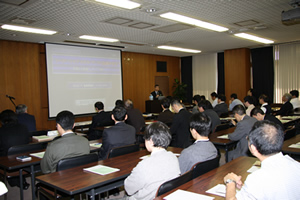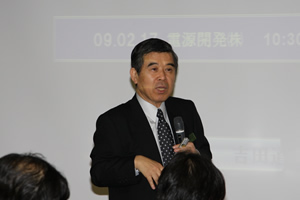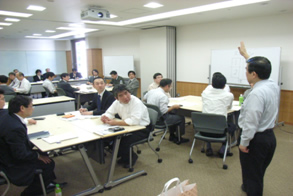|
|
 |
|
The 110th Safety Caravan was conducted at Electric Power Development Co., Ltd. (Nuclear Power Division) in Chuo City, Tokyo on February 17, 2009. |
| Safety Presentation |

|
|
During the Safety Presentation
|
39 employees of Electric Power Development Co., Ltd. (J-POWER) attended the Safety Caravan.
Mr. Junji Nagashima, General Manager of the Nuclear Power Construction Department, gave the opening statement: "As an organization, we are able to implement large projects properly by tactfully exercising the strengths of each and every individual. That is to say, unless we make one plus one equal more than two, I believe that we will not be able to accomplish good work. To that end, I feel it is important that the ideas put forth by each individual be translated into practice and adequately shared throughout the whole organization. Today, I hope that Professor Yoshida will discuss something along those lines.
After the opening statement, Professor Michio Yoshida of the Center for Educational Research and School Development, Faculty of Education, Kumamoto University, gave a safety presentation entitled "Human Skill Improvement and Organizational Safety: Group Dynamics." |

|
|
Professor Michio Yoshida ,
Center for Educational Research
and School Development,
Faculty of Education, Kumamoto University
|
- In organizations, leadership plays an important role. However, in order for it to be appropriately demonstrated, the support of followers around the leader is also essential. When we talk about leadership, often it is only the responsibility of the leader that is emphasized. However, followers also need to respond appropriately to a leader's approach. Leadership directs its influence from top to bottom, but the flow from bottom to top, in which effective followers foster an effective leader, should also be valued. Additionally, the larger the number of followers, the greater the challenge facing the leader to improve his people skills along with the required high level of specialized expertise. Unless the leader hones not just the extent of his knowledge and technological know-how but also his people skills, it will be difficult for him to exercise leadership in relation to the followers.
- A leader's merits and demerits are not determined by his individual talents, but by his actions. In other words, what kind of distinguishing qualities the individual leader has is not the issue. It is the actions which he takes that are important. However, what is meant here by action is not mere physical movement, but action refers to the approach visible to subordinates, younger colleagues and team members and also includes the leader's use of language. It is precisely this sort of action that becomes a major factor affecting leadership. Even if a leader takes the variety of actions in keeping with the situation and circumstances as demanded by followers, there will be some cases where these actions work well, and then others where they do not. Consequently, the leader must continue to extend his endeavors within a certain tense atmosphere. And, he must continue to improve while considering all possible actions in order to demonstrate his leadership. Additionally, when evaluating whether or not an action was appropriate, it is important to give consideration to not only self-evaluations, but also the assessments of others such as subordinates, colleagues as well as superiors.
- PM theory is a leading approach to thinking about leadership from the perspective of action. Under this theory, actions required of leaders are believed to be divided into P and M. The former is action taken to achieve work objectives and symbolized by the first letter of the term "performance." It comprises formulating plans, giving instructions to subordinates, guiding subordinates, and moreover demonstrating specialized capabilities to achieve the objectives. On the other hand, M action is the action taken for consolidating groups and maintaining interpersonal relationships, and is symbolized by the first letter of the term "maintenance." It has been explicitly shown that subordinates working under a leader who has a PM style in which there are high levels of both P actions and M actions have a high degree of satisfaction and interest in their work, have stable mental health, and are highly safety conscious. Moreover, there is also data showing a low incidence of accidents. Hence, people who are leaders should work toward the ideal of being a leader possessing a PM style with high levels of both P and M actions.
|
Group Work |

|
|
During the Group Work
|
Based on a request from the Electric Power Development Co., Ltd., group work was conducted during the safety information exchange meetings before and after lunch. Approximately 20 core leaders in the Nuclear Power Division participated in these sessions under the guidance of Professor Michio Yoshida of the Center for Educational Research and School Development, Faculty of Education, Kumamoto University.
In the questionnaire after the presentation and group work, the following opinions were expressed.
- It was easy to understand and helpful.
- I would like a broader range of people to be exposed to this kind of approach and have it adopted throughout the entire workplace in the future.
- It is also important to have each individual think thoroughly about what safety is.
- It would have be even more worthwhile if we were able to actually experience specific examples of leadership and their effectiveness.
- I would like to learn about how to correlate leadership and nuclear safety.
|
|
|







